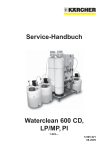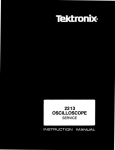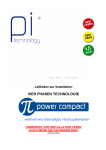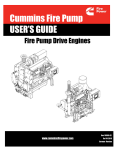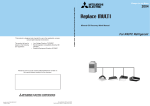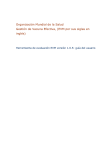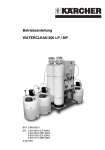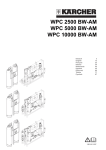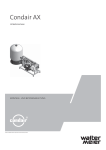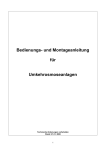Download Register and win! WPC 5000 SW-AM
Transcript
WPC 5000 SW-AM Deutsch English Español 3 13 23 R e w gis w w. te ka r a er n ch d er .c w om in! 59620150 05/12 2 Deutsch DE -1 3 Lesen Sie vor der ersten Benutzung Ihres Gerätes diese Originalbetriebsanleitung, handeln Sie danach und bewahren Sie diese für späteren Gebrauch oder für Nachbesitzer auf. Inhaltsverzeichnis Bedienelemente . . . . . . . . . Sicherheitshinweise . . . . . . Bestimmungsgemäße Verwendung . . . . . . . . . . . . . . . . . . Umweltschutz . . . . . . . . . . . Inbetriebnahme. . . . . . . . . . Betrieb . . . . . . . . . . . . . . . . Pflege und Wartung . . . . . . Verbrauchsmaterial. . . . . . . Hilfe bei Störungen . . . . . . . Technische Daten . . . . . . . . EG-Konformitätserklärung . Garantie . . . . . . . . . . . . . . . Zubehör und Ersatzteile . . . .. .. .. .. .. .. .. .. .. .. .. 2 2 2 3 3 5 6 7 7 7 7 Bedienelemente 1 2 3 4 5 6 7 8 9 10 11 12 13 14 15 16 17 18 19 20 21 22 23 24 25 26 4 Spültank Manometer Ausgangsdruck Steuerung Mediafilter/Aktivkohlefilter Manometer Eingangsdruck Mediafilter/Aktivkohlefilter Sicherheitshinweise DE . . 2 DE . . 2 DE DE DE DE DE DE DE DE DE DE DE 27 28 29 30 31 Bedienfeld Schaltschrank Hauptschalter Betriebsartschalter Drehschalter Reinigung Ein/Aus Spülanschluss Druckschalter Durchflussmengenmesser für Konzentrat Durchflussmengenmesser für Trinkwasser Feinfilter Manometer Ausgangsdruck Feinfilter Manometer Eingangsdruck Feinfilter Eingangsventil Dosierstelle für Nachchlorung Manometer Trinkwasser Probenahme Trinkwasser Druckhalteventil Dosierstelle Antiscalant Probenahme Rohwasser Manometer Membraneingang Manometer Membranausgang Spülventil Turbocharger Spülpumpe Druckrohr mit Membranen Druckrohr mit Membranen Allgemein Trinkwasser – Trinkwasserqualität ist nur bei fristgerechter Überwachung der Anlage gewährleistet. Bitte die in dieser Betriebsanleitung angegebenen Kontrollen termingerecht ausführen. – Trinkwasserqualität in regelmäßigen Abständen prüfen lassen. – Trinkwasserverordnung beachten. Chemikalien – Beim Umgang mit Chemikalien säurebeständige Schutzhandschuhe und Schutzbrille tragen. – Chemikalien kühl, trocken und bei Temperaturen über 5°C lagern. – Chemikalien für Kinder unzugänglich aufbewahren. – Beim Umgang mit Chemikalien für gute Durchlüftung des Raumes sorgen. – In der Nähe muss sich eine Waschgelegenheit befinden. – Augenwaschflasche bereithalten. – Sicherheitshinweise auf dem EG-Datenblatt sowie Unfallmerkblatt der betreffenden Chemikalien beachten. Elektrische Anlage – Der elektrische Anschluss muss von einem Elektroinstallateur ausgeführt werden und IEC 60364-1 entsprechen. – Beschädigte oder durchtrennte Netzkabel niemals berühren. Gegebenenfalls sofort den Netzstecker ziehen. – Anlage niemals mit beschädigtem Netzkabel betreiben. Symbole in der Betriebsanleitung Gefahr Für eine unmittelbar drohende Gefahr, die zu schweren Körperverletzungen oder zum Tod führt. 몇 Warnung Für eine möglicherweise gefährliche Situation, die zu schweren Körperverletzungen oder zum Tod führen könnte. Vorsicht Für eine möglicherweise gefährliche Situation, die zu leichten Verletzungen oder zu Sachschäden führen kann. DE -2 Bestimmungsgemäße Verwendung – – Die Anlage wird zur Aufbereitung von Meerwasser eingesetzt. Durch den modularen Aufbau können in Abhängigkeit von der Rohwasserqualität Trübstoffe, Härtebildner, Salze, Bakterien und Viren abgetrennt werden. Umweltschutz Die Verpackungsmaterialien sind recyclebar. Bitte werfen Sie die Verpackungen nicht in den Hausmüll, sondern führen Sie diese einer Wiederverwertung zu. Altgeräte enthalten wertvolle recyclingfähige Materialien, die einer Verwertung zugeführt werden sollten. Batterien, Öl und ähnliche Stoffe dürfen nicht in die Umwelt gelangen. Bitte entsorgen Sie Altgeräte deshalb über geeignete Sammelsysteme. Inbetriebnahme Gefahr Verletzungsgefahr durch unsachgemäß installierte Anlage. Gesundheitsgefahr durch schlecht aufbereitetes Trinkwasser. Die Anlage darf nur in Betrieb genommen werden, wenn sie durch geschultes, autorisiertes Personal aufgebaut, installiert und für den Betrieb vorbereitet wurde. Vor Inbetriebnahme Verbindung der Anlage mit der Rohwasserquelle prüfen. Ungehinderten Ablauf des erzeugten Trinkwasser in einen Tank oder eine geeignete nutzerseitige Einrichtung sicherstellen. Hinweis Das Trinkwasser muss ohne Gegendruck abließen können. Die Höhendifferenz darf 3 m nicht übersteigen. Dosierstation befüllen Hinweis Ist die Anlage mit einer oder mehreren Dosierstationen ausgestattet, muss sichergestellt sein, dass diese korrekt angeschlossen und befüllt sind. Dosierstation befüllen (siehe Kapitel „Pflege und Wartung/Wartungsarbeiten“). Betrieb Anlage einschalten Prüfen, ob die Netztecker der Dosierpumpen der Dosierstationen mit den Steckdosen an der Anlage verbunden sind. Stellung des Betriebsartschalters kontrollieren: Stellung „Automatik“: die Anlage wird von einem externen Schwimmerschalter im Trinkwassertank gesteuert. Stellung „Hand“: die Anlage wird manuell über den Hauptschalter einund ausgeschaltet. Hauptschalter in Stellung „1“ drehen, die Trinkwasserproduktion startet. Überwachungselemente Display Media- und Aktivkohlefilter – Anzeige der Uhrzeit Display des Bedienfeldes Abwechselnde Anzeige von: – Abnahme / Standby – Trinkwasserleitwert – Trinkwassertemperatur Anlage ausschalten 몇 Warnung Beschädigungsgefahr. Wird die Anlage länger als 14 Tage ausgeschaltet, muss eine Konservierung durch den Kärcher Kundendienst durchgeführt werden. Hauptschalter auf „0“ drehen, die Anlage stoppt die Trinkwasserproduktion. Hinweis Anlage nicht über Nacht abschalten! Nachts wird die automatische Reinigung der Vorfilter durchgeführt. Beim Unterbleiben dieser Reinigung besteht die Gefahr von Schäden an der Anlage. Pflege und Wartung Gefahr Gesundheitsgefahr durch schlechte Trinkwasserqualität. Zur Sicherstellung der Trinkwasserqualität müssen die Kontrollen im folgenden Wartungsplan fristgerecht ausgeführt werden. Lassen sich Abweichungen vom Sollzustand nicht durch die angegebenen Maßnahmen beheben, muss die Trinkwasserproduktion gestoppt und der Kärcher Kundendienst verständigt werden. DE -3 5 Wartungsplan Zeitpunkt täglich Kontrolle/Tätigkeit Füllstand Dosierbehälter Luftblasen in den Dosierleitungen Trinkwasserfluss ausgehend vom Inbetriebnahmewert Trinkwasserleitwert ausgehend vom Inbetriebnahmewert Druckdifferenz Pumpen- und Konzentratdruck Betriebszähler Media- und Aktivkohlefilter Druckunterschied Feinfilter Sichtkontrolle der Anlage wöchentlich Betriebsprotokoll ausfüllen monatlich Dosierbehälter reinigen und spülen Schwimmerschalter im Trinkwassertank Wartungsarbeiten Media- und Aktivkohlefilter ablesen 1 Display 2 Taste ADVANCE Während des Betriebes wird die aktuelle Uhrzeit im Display angezeigt. Taste ADVANCE 5 bis 6 Sekunden lang drücken. Im Display erscheint die Anzeige erste Zustandsanzeige aus der unten stehenden Liste. Zum Weiterschalten auf die nächste Anzeige, Taste ADVANCE jeweils kurz drücken. Display Bedeutung 2000 ohne Bedeutung 0000 ohne Bedeutung D–07 Verbleibende Tage bis zur nächsten Rückspülung –001 Anzahl der ausgeführten Rückspülungen 0–01 Tage–Stunden seit der letzten Rückspülung Soll ausreichende Befüllung keine Luftblasen Absinken innerhalb 10% Bei Abweichung auffüllen Dosierpumpe entlüften Feinregulierung Anstieg innerhalb 10% Feinregulierung maximal 15% über Inbetriebnahmedifferenz Rückspülung hat innerhalb der letzten 24 Stunden stattgefunden maximal 0,08 MPa (0,8 bar) keine Undichtigkeiten Kärcher Kundendienst Kärcher Kundendienst keine Funktionsstörung erkennbar Kärcher Kundendienst Dosierpumpe entlüften Die Dosierpumpe muss entlüftet werden, falls die Pumpe Luft angesaugt hat. 1 2 3 Taster Dosierfrequenz Verschraubung Dosierpumpe WPC 5000 SW-AM stoppen: Dosierpumpe schaltet ab. Ursache der Luftansaugung beheben, gegebenenfalls Kundendienst benachrichtigen. Verschraubung an der Dosierpumpe lockern. Eingestellte Dosierfrequenz an den LEDs auf der Dosierpumpe ablesen und merken. Dosierfrequenz durch wiederholtes Drücken des Tasters Dosierfrequenz auf 100% einstellen und warten bis keine Blasen mehr in der Saugleitung sind (ca. 1 Minute). Austretende Dosierflüssigkeit mit einem Lappen aufnehmen. Verschraubung festziehen. Dosierpumpe wieder auf ursprüngliche Dosierfrequenz einstellen. Feinfilter wechseln Kärcher Kundendienst Feinfilter wechseln Druckdifferenz der beiden Manometer prüfen. Bei mehr als 0,08 MPa (0,8 bar) Filtereinsatz wechseln: Anlage mit ON/OFF-Taste abschalten. Hauptschalter in Stellung „0“ drehen. WPC 5000 SW-AM: 1 2 3 4 Entlüftung Filterdeckel Filtergehäuse Probenahmehahn (Rohwasser) Wird die Taste ADVANCE einige Zeit nicht mehr betätigt, springt das Display auf die Anzeige der Uhrzeit zurück. 1 6 1 Knebelschraube 2 Filterkerze Feinfilter an Probenahmehahn (Rohwasser) drucklos machen. Filterdeckel abschrauben. Wasser im Filter am Probenahmehahn (Rohwasser) ablassen. Taste Return DE -4 Knebelschraube an den Filterkerzen lösen. Filterkerze entnehmen. Neue Filterkerze einsetzen. Knebelschraube aufschrauben. Filtergehäuse mit Rohwasser vollständig auffüllen. Filterdeckel aufschrauben, dabei Schrauben über Kreuz anziehen. Hauptschalter auf „1“ drehen. Gegebenenfalls Anlage mit Drehschalter „Hand/Auto“ in Stellung „Hand“ starten. Sofort danach Filter entlüften. Gegebenenfalls Drehschalter in Stellung „Auto“ bringen. Feinregulierung der Betriebsdrücke 몇 Warnung Beschädigungsgefahr für die Anlage. Folgende Werte dürfen nicht überschritten werden: – Pumpendruck maximal 7 MPa – Trinkwassermenge maximal 5000 l/h – Konzentratmenge mindestens 10000 l/h Hinweis Die Druckeinstellungen sind nur über die Drehzahl der Pumpe zu verändern. Dies darf nur vom KÄRCHER-Kundendienst vorgenommen werden. (1) Trinkwasserfluss von _____ l/h auf _____ l/h gesunken Trinkwassermenge am Durchflussmesser Trinkwasser ablesen und mit dem Wert bei Inbetriebnahme vergleichen (siehe Inbetriebnahmeprotokoll). Ist der Trinkwasserfluss auf _____l/h gesunken, KÄRCHER-Kundendienst verständigen. (2) Leitfähigkeit des Trinkwassers von _____μS/cm auf _____μS/cm gestiegen Hinweis Kleine Erhöhungen der Trinkwasserleitfähigkeit beeinträchtigen die Trinkwasserqualität nicht. Aktuellen Leitwert im Display des Bedienfeldes ablesen und mit dem Wert bei Inbetriebnahme vergleichen (siehe Inbetriebnahmeprotokoll. Ist der Trinkwasserleitwert auf _____μS/cm gestiegen, muss der KÄRCHERKundendienst verständigt werden. Chemie anmischen Gefahr Verätzungsgefahr durch Chemikalien. Beim Umgang mit Chemikalien säurebeständige Schutzhandschuhe und Schutzbrille tragen. Hinweis Die Werte für die Dosierung der verschiedenen Chemikalien ergeben sich aus der Rohwasseranalyse und der Anlagenleistung. Der Kärcher Kundendiensttechniker trägt bei der Inbetriebnahme die für Ihre Anlage erforderlichen Dosiermengen in die nachstehende Dosiertabelle ein. Dosiertabelle Dosierbehälter Chemikalie Dosierung pro 10 l Dosierlösung [ml] Vorchlorung RM 852 Entkeimungsmittel Anti Scalant RM 5000 Härtestabilisierung Nachchlorung RM 852 Entkeimungsmittel 1 2 3 4 Deckel Mischstab Dosierpumpe Dosierbehälter Schutzhandschuhe anziehen und Schutzbrille aufsetzen. Kanister aus der Dosierstation entnehmen. Gefahr Verletzungsgefahr durch chemische Reaktion. Die Dosierstationen dürfen nicht verwechselt und dadurch mit der falschen Chemikalie befüllt werden. 몇 Warnung Gefahr von Ausflockung oder anderen, unerwünschten, chemischen Reaktionen. Zum Anmischen der Chemikalien nur chlorfreies Trinkwasser aus dem TrinkwasserProbenhahn verwenden. Die Dosierung wird in Abhängigkeit des Füllstandes im Dosierbehälter durchgeführt. Teilentleerter Dosierbehälter: Füllstand des Dosierbehälters an der Skala ablesen, z.B. 50 l. Nachfüllmenge ermitteln, dazu den abgelesenen Füllstand von 200 l abzienen. Im Beispiel 200 l – 50 l = 150 l. Aus der Dosiertabelle die erforderliche Menge der entsprechenden Chemikalie ermitteln. Im Beispiel 15 x die Menge für 10 l Wasser. Die ermittelte Menge der entsprechenden Chemikalie abmessen und in den Dosierbehälter füllen. Dosierbehälter bis zur Marke „200 l“ mit Trinkwasser füllen. Deckel der Dosierstation schließen. Mischstab bis zum Anschlag aus dem Dosierbehälter ziehen und wieder zurückschieben. Diesen Vorgang ca. 2 Minuten lang wiederholen, bis die Chemikalie vollständig vermischt ist. Hinweis Bei der Anlage WPC 5000 SW-AM fasst der Dosierbehälter 200 Liter. Verbrauchsmaterial Bezeichnung Bestell-Nr. RM 852 Entkeimungsmittel RM 5000 Härtestabilisierung Feinfilter 6.414-812.0 Vollständig entleerter Dosierbehälter: 20 l Trinkwasser in den Dosierbehälter füllen. Mit einem Messbecher das 20-fache der in der Dosiertabelle angegebenen Menge abmessen und in den Dosierbehälter füllen. Dosierbehälter bis zur Marke „200 l“ mit Trinkwasser füllen. Deckel der Dosierstation schließen. Mischstab bis zum Anschlag aus dem Dosierbehälter ziehen und wieder zurückschieben. Diesen Vorgang ca. 2 Minuten lang wiederholen, bis die Chemikalie vollständig vermischt ist. Dosierpumpe nach den Hinweisen im Kapitel „Pflege und Wartung“ entlüften. DE -5 7 Hilfe bei Störungen Störungen an der RO-Anlage Störungen an der RO-Anlage werden von den LEDs auf dem Bedienfeld und auf dem Display angezeigt. Bezeichnung/ Anzeige LED Display Hinweis Tritt eine Störung auf, wird die Anlage automatisch abgeschaltet und die Trinkwasserproduktion unterbrochen. Kann die Störung nicht behoben werden, Anlage ausschalten und Kärcher Kundendienst verständigen. Ursache Läuft die Anlage im Automatikbetrieb nicht an, Stromversorgung unterbrechen. Dabei wird die Steuerung zurückgesetzt. Weitere Störungen nach den Angaben in den folgenden Tabellen beheben. Abhilfe Störung allgemein, Details siehe Display. CD max Permeatleitwert zu hoch. Stop Aktivkohle- oder Mediafilter wird gereinigt. Spannungsausfall, Uhr stellen CD Permeat Max CD Permeat Min Wassermangel Stromzufuhr war unterbrochen. Mit Störungstaste quittieren, gegebenenfalls Kundendienst verständigen. Reinigungsvorgang abwarten, Anlage startet automatisch. Mit Störungstaste quittieren. Permeatleitwert zu hoch. Kundendienst verständigen. Leitwertsonde defekt. Feinfilter verstopft. Rohwasserzufuhr unterbrochen. Kundendienst verständigen. Austauschen, mit Störungstaste quittieren. Rohwasserzufuhr wiederherstellen, gegebenenfalls Kundendienst verständigen. Kundendienst verständigen. Kundendienst verständigen. Dosierbehälter füllen und anschließend Störung quittieren. Kundendienst verständigen. Kundendienst verständigen. Kundendienst verständigen. Temperatur des Aufstellraums prüfen, gegebenenfalls beheizen. Rohwasserzufuhr prüfen, gegebenenfalls Kundendienst verständigen. Motorschutz Druckschalter defekt. Hochdruckpumpe defekt. Dosierbehälter ist leer CD MB überschr. Permeatleitfähigkeit zu hoch. Leitwertsonde defekt. Max. Q.-Spülzeit Permeatleitfähigkeit zu hoch. Frostgefahr Raumtemperatur zu niedrig. Rohwassertemperatur zu niedrig. Störungen an den Dosierstationen Dosierpumpe fördert zu viel oder zu wenig Dosierpumpe fördert nicht 8 Dosierfrequenz oder Dosierhub verstellt. Dosierfrequenz oder Dosierhub einstellen. Netzstecker der Dosierpumpe nicht eingesteckt. Anlage nicht eingeschaltet. Dosierpumpe nicht entlüftet. Dosiermembrane defekt. Netzstecker an der Anlage einstecken. Anlage einschalten. Dosierpumpe entlüften. Kundendienst verständigen. DE -6 Technische Daten Umgebungstemperatur Lagertemperatur, min. Luftfeuchtigkeit, max. Versorgungsspannung, Anlage Steuerung Media- / Aktivkohlefilter Dosiermodule Elektrische Absicherung Elektrischer Anschlusswert Rohwassertemperatur Bezugstemperatur pH-Wert Rohwasser pH-Wert Reinigungsmittel zur Reinigung der Anlage Zulaufdruck Rohwasser Leistungsbereich Trinkwasserleistung max. Abmessungen (H x B x T) WPC 5000 SW Aktivkohlefilter Mediafilter Gewicht im Lieferzustand WPC 5000 SW Aktivkohlefilter ohne Füllung Füllung Aktivkohlefilter Mediafilter ohne Füllung Füllung Mediafilter Auslegungsbasis für Rohwassersalzgehalt (bei 25 °C) – EG-Konformitätserklärung Hiermit erklären wir, dass die nachfolgend bezeichnete Maschine aufgrund ihrer Konzipierung und Bauart sowie in der von uns in Verkehr gebrachten Ausführung den einschlägigen grundlegenden Sicherheitsund Gesundheitsanforderungen der EGRichtlinien entspricht. Bei einer nicht mit uns abgestimmten Änderung der Maschine verliert diese Erklärung ihre Gültigkeit. Produkt: Typ: Trinkwasseraufbereitungsanlage 1.024-xxx Einschlägige EG-Richtlinien 2006/42/EG (+2009/127/EG) 2006/95/EG 2004/108/EG Angewandte harmonisierte Normen EN 50178 EN 60204-1 EN 55011: 2003 EN 55014–1: 2006 + A1: 2009 EN 55014–2:1997 +A1:2001 EN 61000–3–2: 2006 + A2: 2009 EN 61000–3–3: 2006 EN ISO 14971 EN 806-1 Angewandte nationale Normen --5.957-716 Die Unterzeichnenden handeln im Auftrag und mit Vollmacht der Geschäftsführung. CEO °C °C % rel. V/Hz V/Hz V/Hz A kW °C °C --MPa l/Tag l/h WPC 5000 SW-AM +1...+50 bis -10 100 400/3~50 primär: 230/1~50 230/1~50/60 63 30 +5...+35 +25 6...9,5 3...11 0,2...0,6 120 000±15% 5000 mm mm mm 1900 x 5000 x 1000 2453 x 2227 x 1181 2453 x 2227 x 1181 kg 2000 kg 400 kg 1000 kg 400 kg 2300 ppm 45000 Weitere Informationen über Ersatzteile erhalten Sie unter www.kaercher.com im Bereich Service. Head of Approbation Dokumentationsbevollmächtigter: S. Reiser Alfred Kärcher GmbH & Co. KG Alfred-Kärcher-Str. 28 - 40 71364 Winnenden (Germany) Tel.: +49 7195 14-0 Fax: +49 7195 14-2212 Winnenden, 2011/11/01 Garantie In jedem Land gelten die von unserer zuständigen Vertriebsgesellschaft herausgegebenen Garantiebedingungen. Etwaige Störungen an Ihrem Gerät beseitigen wir innerhalb der Garantiefrist kostenlos, sofern ein Material- oder Herstellungsfehler die Ursache sein sollte. Im Garantiefall wenden Sie sich bitte mit Kaufbeleg an Ihren Händler oder die nächste autorisierte Kundendienststelle. Zubehör und Ersatzteile – Es dürfen nur Zubehör und Ersatzteile verwendet werden, die vom Hersteller freigegeben sind. Original-Zubehör und Original-Ersatzteile bieten die Gewähr dafür, dass das Gerät sicher und störungsfrei betrieben werden kann. DE -7 9 Betriebsprotokoll WPC (A) Inbetriebnahmedaten mit Übergabeprotokoll Anlagentyp: 1.024- Werknummer: Datum der Inbetriebnahme: Ort der Installation: Art der Rohwasserquelle: Kunde: Betriebsstundenanzeige [h] Rohwasserhärte [°dH] Leitfähigkeit Rohwasser [μS/cm] pH-Wert Rohwasser [pH] Rohwassertemperatur [°C] Mediafilter Eingangsdruck bei Betrieb [MPa] Mediafilter Eingangsdruck bei Rückspülung [MPa] Aktivkohlefilter Eingangsdruck bei Betrieb MPa] Aktivkohlefilter Eingangsdruck bei Rückspülung [MPa] Feinfilter Eingangsdruck [MPa] Feinfilter Ausgangsdruck [MPa] Konzentratdruck [MPa] Membraneingangsdruck [MPa] Trinkwassermenge [l/h] Konzentratmenge [l/h] Ausbeute [%] Trinkwasserleitfähigkeit [μS/cm] Dosierpumpe Flockung Hub / Frequenz [%] Dosierpumpe Vorchlorung Hub / Frequenz [%] Dosierpumpe Antiscalant Hub / Frequenz [%] Dosierpumpe Nachchlorung Hub / Frequenz [%] Bemerkungen: Bestätigung: Die Anlage wurde vollständig funktionsfähig in Betrieb genommen und übergeben. Der Kunde wurde ausdrücklich darauf hingewiesen, dass das durch die Anlage produzierte Wasser vor der Nutzung als Trinkwasser entsprechend den örtlichen Vorschriften durch eine zugelassene Stelle überprüft und als Trinkwasser freigegeben werden muss. Außerdem wurde auf die erforderliche Führung des Betriebsprotokolls, die Gefahren im Umgang mit Chemikalien sowie auf die Gefahren durch ein Vertauschen der Chemikalien ausdrücklich hingewiesen. Ort, Datum, Unterschrift (Kunde) 10 Ort, Datum, Unterschrift (Kärcher-Service) DE -8 Protokollseite____ DE -9 Störungen Bemerkungen Betriebsdaten Druck im Betrieb [MPa] 1Pr08 Blattnummer: Druck während Anfahren [MPa] 1Pr08 Ort der Installation: Leitfähigkeit [μS/cm] Display Werknummer: Trinkwassermenge [l/h] 1Fl02 Anlagentyp: 1.024- Anzahl Rückspülungen Aktivkohlefilter Anzahl Rückspülungen Mediafilter Konzentratmenge [l/h] 1Fl01 Konzentratdruck [MPa] 1Pr 06 Membraneingangsdruck [MPa 1Pr05 Pumpendruck [MPa] 1Pr04 Druck nach Feinfilter [MPa] 1Pr02 Druck vor Feinfilter [MPa] 1Pr01 Rohwasser Betriebsstunden [h] Temperatur [°C] Bediener Datum Betriebsprotokoll WPC (B) Protokoll der Betriebsdaten Art der Rohwasserquelle: Trinkwasser (Bitte diese Seite nach Ausfüllen der Kopfdaten zur weiteren Protokollierung vervielfältigen) 11 Rückseite. Bleibt leer, damit das Blatt herausgetrennt werden kann 12 DE - 10 English EN -1 13 Please read and comply with these original instructions prior to the initial operation of your appliance and store them for later use or subsequent owners. Contents Control elements. . . . . . . . . Safety instructions . . . . . . . Proper use . . . . . . . . . . . . . Environmental protection . . Start up . . . . . . . . . . . . . . . . Operation . . . . . . . . . . . . . . Maintenance and care . . . . Consumables . . . . . . . . . . . Troubleshooting . . . . . . . . . Technical specifications . . . EC Declaration of Conformity Warranty . . . . . . . . . . . . . . . Accessories and Spare Parts 12 13 14 15 16 17 18 19 20 21 22 23 24 25 26 14 Rinse tank Manometer output pressure Control media filter/ active carbon filter Manometer input pressure Media filter/ active carbon filter Safety instructions EN EN EN EN EN EN EN EN EN EN EN EN EN .. .. .. .. .. .. .. .. .. .. .. .. .. 2 2 2 2 2 3 3 5 6 7 7 7 7 Control elements 1 2 3 4 5 6 7 8 9 10 11 27 28 29 30 31 Operating field Control board Main switch Operating type switch Rotary switch - cleaning ON/OFF Rinse connection Pressure switch Flowmeter for concentrate Flowmeter for drinking water Fine filter Manometer for output pressure of fine filter Manometer for inlet pressure of fine filter Input valve Dosing location for secondary chlorination Drinking water pressure gauge Sample extraction - drinking water Pressure holding valve Dosing location antiscalant Sample extraction raw water Membrane input pressure gauge Membrane output pressure gauge Flush valve Turbo charger Rinse pump Pressure pipe with membranes Pressure pipe with membranes General Drinking water – Drinking water quality can only be ensured if the plant is monitored at regular intervals. Please conduct the checks given in this operating instructions manual according to the schedule. – Please get the drinking water quality checked at regular intervals. – Follow the drinking water regulations. Chemicals – Please wear safety gloves and safety goggles while handling acid-resistant chemicals. – Store the chemicals in a cool and dry place and at temperatures above 5°C. – Store chemicals away from the reach of children. – Ensure proper ventilation in the room while handling chemicals. – There must be a washing room closeby. – Keep an eye-washing liquid bottle handy. – Please follow the safety instructions on the EC data sheet and the accident sheet of the concerned chemicals. Electrical system – The electrical connections must be done by an electrician according to IEC 60364-1. – Never touch damaged or ripped mains cables. If required, pull out the plug from the socket immediately. – Never operate the unit with damaged cable. Symbols in the operating instructions Danger Immediate danger that can cause severe injury or even death. 몇 Warning Possible hazardous situation that could lead to severe injury or even death. Caution Possible hazardous situation that could lead to mild injury to persons or damage to property. EN -2 Proper use – – The plant is used for treating sea water. Due to the modular structure, turbid substances, hardeners, salts, bacteria and water can be separated depending on the quality of raw water. Environmental protection The packaging material can be recycled. Please do not throw the packaging material into household waste; please send it for recycling. Old appliances contain valuable materials that can be recycled; these should be sent for recycling. Batteries, oil, and similar substances must not enter the environment. Please dispose of your old appliances using appropriate collection systems. Start up Danger Risk of injury if the plant is not installed properly. Risk to health on account of poorly treated drinking water. The plant may be put into operation only when set-up, installed and prepared for operation by skilled and authorized personnel. Before Commissioning Check the connection of the plant to the raw water source. Ensure uninterrupted flow of the generated drinking water into a tank or a suitable user-side facility. Note The drinking water must be able to flow out without any counter-pressure. The height difference must not be more than 3 m. Filling up the dosing station Note If the plant is fitted with one or more dosing stations, then it needs to be ensured that this has been connected properly and filled up. Fill up dosing station (refer to Chapter "Maintenance and Care/ Maintenance jobs") Operation Switching on the plant Check whether the mains plug of the dosing pumps of the dosing stations is connected to the sockets of the plant. Check the position of the operating swtich: "Automatic“ position: the plant is controlled by an external floater switch in the drinking water tank. "Manual" position: the plant is manually switched on and off using the main switch. Turn the main switch to position "1"; drinking water production will start. Monitoring elements Display media and active carbon filters – Display time Display of the operating panel Alternating display of: – Acceptance / standby – Drinking water index value – Drinking water temperature Switching off the plant 몇 Warning Risk of damage. If the plant is to be shut down for more than 14 days, then Kärcher Customer Service must carry out some preservative tasks. Turn main switch to "0"; the plant will stop production of drinking water. Note Do not switch off the plant overnight! The prefilters are automatically cleaned during the night. There is a risk of damage to the plant if you do not do this cleaning. Maintenance and care Danger Health hazard on account of poor quality of drinking water. The control tasks outlined in this maintenance plan are to be carried out according to the schedule in order to ensure the quality of drinking water. If the deviations in the target values cannot be corrected by taking the prescribed measures, then stop production of drinking water and inform Kärcher Customer Service immediately. EN -3 15 Maintenance schedule Time daily weekly monthly Check / Activity Filling level of dosing container Air bubbles in the dosing pipes Drinking water flow based on the startup value Drinking water guide value based on the startup value Pressure difference between pump and concentrate pressure Counter/meter for media and active carbon filters Target value adequate filling no air bubbles Lowered by less than 10% Increase within 10% In case of deviation refill Bleed dosing pump. Fine regulation Fine regulation maximum 15% above startup difference Kärcher Customer Service Kärcher Customer Service Replace fine filter Kärcher Customer Service Pressure difference fine filter Visual inspection of the plant Reflushing has taken place in the last 24 hours maximum 0.08 MPa (0.8 bar) no leaks Fill up operations log Clean and rinse dosing container Float switch in drinking water tank no functional disruption can be detected Maintenance Works Check media and active carbon filters 1 Display 2 ADVANCE key During operations, the current time is shown in the display. Press ADVANCE key for 5 to 6 seconds. The display will show the first status display from the list shown beloe. To go to the next display, press once again the ADVANCE key briefly. Display Significance 2000 Not important 0000 Not important D–07 Number of days until the next reflushing –001 Number of reflushing that have been conducted 0–01 days - hours since the last reflushing Bleed dosing pump. The dosing pump must be ventilated if the pump has sucked in air. 1 2 3 Dosing frequency button Screw connections Dosing pump Stopping the WPC 5000 SW-AM: Dosing pump switches off. Fix cause for air suctioning, contact customer service if necessary. Loosen screws on the dosing pump. Read and note the dosing frequency that has been set at the LEDs of the dosing pump. Set the dosing frequency to 100% by repeatedly pressing the dosing frequency button and waiting until there are no more bubbles in the suction pipe (approx. 1 minute). Absorb the oozing dosing liquid with a piece of cloth. Tighten the screws. Set the dosing pump to the original dosing frequency. Kärcher Customer Service Replace fine filter Check the pressure difference between the two manometers. Change filter inlay if value is more that 0.08 MPa (0.8 bar): Switch off the unit using the "ON/OFF" key. Turn the main switch to position "0" WPC 5000 SW-AM: 1 2 3 4 Venting Filter cover Filter casing Sample extraction tap (raw water) If you do not press the ADVACE key for some time, the display goes back to showing the time. 1 16 1 Thumb screw 2 Filter candle Take the pressure of the fine filter on sample extraction tap (raw water). Return key EN -4 Remove the filter cover. Drain the water in the filter on the sample extraction tap (raw water). Release the thumb screw on the filter cartridge. Take out the filter cartridge. Insert new filter cartridge. Screw on the thumb screw. Completely fill the filter housing with raw water. Screw on the filter cover, tighten the screws gently in a diagonal sequence. Set main switch to “1”. If necessary, switch the system to "Manual" using the rotary switch "Manual/Auto". Ventilate the filter immediately afterwards. Turn the rotary switch into the "Auto" position if necessary. Fine regulation of the operating pressures 몇 Warning Danger of damage to the plant. The following values must never be exceeded: – Maximum pump pressure 7 MPa – Maximum drinking water quantity 5,000 l/h – Concentrate quantity min. 10,000 l/h Note The pressure settings can only be changed via the speed of the pump. Only KÄRCHER customer service technicians are permitted to adjust this. (1) Drinking water flow has fallen from _______ l/h to _______ l/h Read the quantity of drinking water at the flow meter for drinking water and compare it to the value when the plant was started (see start-up report). If the drinking water flow has fallen to ______ l/h, contact the KÄRCHER customer service. (2) Conductivity of drinking water has increased from _____μS/cm to _____μS/ cm Note Small increases in the conductivity of drinking water does not affect the quality of the drinking water. Read the current conductivity value on the display of the operating panel and compare it to the value at the time of start-up (see start-up report). If the drinking water value has increased to _____μS/cm, contact the KÄRCHER customer service. Mixing the chemicals Danger Risk of burns injury on account of chemicals. Please wear safety gloves and safety goggles while handling acid-resistant chemicals. Note The values for dosing the different chemicals are based on the raw water analysis and the plant output. Kärcher Customer Service will enter the dosing quantities required for your plant in the following table at the time of startup. Dosing table Dosing container Chemical Prechlorination RM 852 Sterilisation agent Antiscalant RM 5000 Hardness stabiliser Postchlorination RM 852 Sterilisation agent Dosing per 10 l of dosing solution [ml] 1 2 3 4 Cover Mixing rod Dosing pump Dosing container Wear safety gloves and safety goggles. Remove the can from the dosing station. Danger Risk of injury on account of chemical reaction. The dosing stations should not get interchanged and be filled up with the wrong chemicals. 몇 Warning Risk of flocculation or other undesirable chemical reactions. Only use chlorine-free drinking water from the drinking water testing tap to mix the chemicals. The dosing depends on the filling level in the dosing container. Fill up the dosing container up to the "200 l" mark with chlorine-free drinking water. Close the cover of the dosing station. Pull out the mixing rod from the dosing container until the stop and push it back into the container. Repeat this process for approx. 2 minutes until the chemicals are fully mixed. Deaerate the dosing pump according to the instructions in the chapter "Maintenance and Care". Partially emptied dosing container: Read the filling level of the dosing container on the scale, for e.g. 50 l. Determine the refill quantity; for that deduct the filling level that you have read from 200 l. In the example: 200 l – 50 l = 150 l. From the dosing table, ascertain the required quantity of the corresponding chemicals. In the example: 15 x the quantity for 10 l water. Measure the ascertained quantity of the corresponding chemical and fill it into the dosing container. Fill up the dosing container up to the "200 l" mark with chlorine-free drinking water. Close the cover of the dosing station. Pull out the mixing rod from the dosing container until the stop and push it back into the container. Repeat this process for approx. 2 minutes until the chemicals are fully mixed. Note With the WPC 5000 SW-AM system, the dosing container holds 200 l. Consumables Description Order No. RM 852 Sterilisation agent RM 5000 Hardness stabiliser Fine filter 6.414-812.0 Fully emptied dosing container. Fill 20 l drinking water in the dosing can. Use the measuring beaker to measure 20 times the quantity indicated in the dosing table and fill it into the dosing container. EN -5 17 Troubleshooting Interruptions in the RO plant The LEDs on the operating panel and on the display will show the interruptions in the RO plant. Description / Display LED Display Note If there is an interruption, the plant gets switched off automatically and the drinking water production is interrupted. If the problem cannot be rectified, switch off the plant and inform Kärcher Customer Service. Cause If the system does not start in automatic mode, interrupt the power supply. The controls will get reset. Rectify other faults according to the details provided in the following tables. Remedy General fault, details - see display. CD max Permeate index value too high. Stop Active carbon or media filter is cleaned. Power failure, set clock CD Permeate max CD Permeate min Low water pressure Power supply was interrupted. Acknowledge with fault key, notify customer service if necessary. Wait for cleaning process, the system will start automatically Acknowledge with fault key. Permeate index value too high. Inform Customer Service. Index value probe is defective. Inform Customer Service. Fine filter blocked. Raw water inflow interrupted. Replace, acknowledge with fault key. Reestablish the raw water inflow, notify customer service if necessary. Inform Customer Service. Inform Customer Service. Fill dosing container and then acknowledge the fault. Inform Customer Service. Inform Customer Service. Inform Customer Service. Check the temperature of the erection room, heat if necessary. Check the raw water inflow, notify customer service if necessary. Pressure switch is defective. Motor protection High-pressure pump defective. Dosing container is empty Exceed range Permeate conductivity too high. CD Index value probe is defective. Max Q-flush time Permeate conductivity too high. Temperature low Room temperature too low. Raw water temperature too low Interruptions in the dosing stations Dosing pump transports too much or too little Dosing pump does not transport. 18 Dosing frequency or dosing stroke is displaced. Adjust the dosing frequency or dosing stroke. Mains plug of the dosing pump not plugged in. Plant is not switched on. Dosing pump is not deaerated. Defective dosing membrane. Connect the mains plug to the unit. Switch on plant. Bleed dosing pump. Inform Customer Service. EN -6 Technical specifications Ambient temperature Storage temperature, min. Humidity, max. Supply voltage, plant Control media/ active carbon filter Dosing module Electrical fuses Electrical connection value Raw water temperature Reference temperature pH value fo raw water pH value of detergent for cleaning the plant Inlet pressure of raw water Output range Drinking water output, max. Dimensions (h x b x d) WPC 5000 SW Active carbon filter Media filter Weight in delivery state WPC 5000 SW Active carbon filter without filling Filling active carbon filter Media filter without filling Filling media filter Design base for salt content in raw water (at 25 ) – EC Declaration of Conformity We hereby declare that the machine described below complies with the relevant basic safety and health requirements of the EU Directives, both in its basic design and construction as well as in the version put into circulation by us. This declaration shall cease to be valid if the machine is modified without our prior approval. Product: Type: Drinking water preparation system 1.024-xxx Relevant EU Directives 2006/42/EC (+2009/127/EC) 2006/95/EC 2004/108/EC Applied harmonized standards EN 50178 EN 60204-1 EN 55011: 2003 EN 55014–1: 2006 + A1: 2009 EN 55014–2:1997 +A1:2001 EN 61000–3–2: 2006 + A2: 2009 EN 61000–3–3: 2006 EN ISO 14971 EN 806-1 Applied national standards --5.957-716 The undersigned act on behalf and under the power of attorney of the company management. CEO °C °C % rel. V/Hz V/Hz V/Hz A kW °C °C --MPa l/day l/h WPC 5000 SW-AM +1...+50 up to -10 100 400/3~50 primary: 230/1~50 230/1~50/60 63 30 +5...+35 +25 6...9,5 3...11 0,2...0,6 120 000±15% 5000 mm mm mm 1900 x 5000 x 1000 2453 x 2227 x 1181 2453 x 2227 x 1181 kg 2000 kg 400 kg 1000 kg 400 kg 2300 ppm 45000 For additional information about spare parts, please go to the Service section at www.kaercher.com. Head of Approbation Authorised Documentation Representative S. Reiser Alfred Kärcher GmbH Co. KG Alfred-Kärcher-Str. 28 - 40 71364 Winnenden (Germany) Phone: +49 7195 14-0 Fax: +49 7195 14-2212 Winnenden, 2011/11/01 Warranty The warranty terms published by the relevant sales company are applicable in each country. We will repair potential failures of your appliance within the warranty period free of charge, provided that such failure is caused by faulty material or defects in manufacturing. In the event of a warranty claim please contact your dealer or the nearest authorized Customer Service centre. Please submit the proof of purchase. Accessories and Spare Parts – Only use accessories and spare parts which have been approved by the manufacturer. The exclusive use of original accessories and original spare parts ensures that the appliance can be operated safely and trouble free. EN -7 19 Operations log WPC (A) Startup date with transfer log Plant type: 1.024- Plant number: Startup date: Installation site: Type of raw water source: Customer: Operating hours display [h] Raw water hardness [°dH] Flow rate of raw water [μS/cm] pH value fo raw water [pH] Raw water temperature [°C] Media filter of inlet pressure during plant running [MPa] Media filter of inlet pressure during return rinsing [MPa] Active carbon filter of inlet pressure during plant running [MPa] Active carbon filter of inlet pressure during return rinsing [MPa] Inlet pressure of fine filter [MPa] Outlet pressure of fine filter [MPa] Concentrate pressure [MPa] Membrane input pressure [MPa] Drinking water quantity [l/h] Concentrate quantity [l/h] Yield [%] Drinking water flow rate [μS/cm] Dosing pump flocking stroke/ frequency [%] Dosing pump pre-chlorination stroke/ frequency [%] Dosing pump anti-scalant stroke/ frequency [%] Dosing pump post-chlorination stroke/ frequency [%] Remarks Confirmation: The plant was started up and handed over in a fully functioning condition. It has been explicitly brought to the notice of the customer that the watre produced by the plant must be checked according to the local standards by an approved testing agency before releasing it as drinking water. Further, it has also been brought to the notice of the customer that the operations log is to be maintained; the customer has also been informed about the risks involved in handling chemicals and the hazards on account of interchanging the chemicals. Place, Date, Signature (Customer) 20 Place, Date, Signature (Kärcher Service) EN -8 Log page____ EN -9 Faults Remarks Operations data Pressure during operation [MPa] 1Pr08 Page number: Pressure during start up [MPa] 1Pr08 Installation site: Flow rate [μS/cm] Display Plant number: Drinking water quantity [l/h] 1Fl02 Plant type: 1.024- Number of backflows Active carbon filter Number of backflows Media filter Concentrate quantity [l/h] 1Fl01 Concentrate pressure [MPa] 1Pr 06 Membrane input pressure [MPa] 1Pr05 Pump pressure [MPa] 1Pr04 Pressure after fine filter [MPa] 1Pr02 Raw water Pressure befor fine filter [MPa] 1Pr01 Operating hours [h] Temperature [°C] Operator Date Operations log WPC (B) Log report of operations data Type of raw water source: Drinking water (Please make copies of this sheet after filling the header data for maintaining additional reports) 21 Rear side. Is kept blank so that the sheet can be separated 22 EN - 10 Español ES -1 23 Antes del primer uso de su aparato, lea este manual original, actúe de acuerdo a sus indicaciones y guárdelo para un uso posterior o para otro propietario posterior. Índice de contenidos Elementos de mando . . . . . ES Indicaciones de seguridad . ES Uso previsto . . . . . . . . . . . . ES Protección del medio ambiente ES Puesta en marcha. . . . . . . . ES Funcionamiento . . . . . . . . . ES Cuidados y mantenimiento . ES Material de uso . . . . . . . . . . ES Ayuda en caso de avería . . ES Datos técnicos . . . . . . . . . . ES Declaración de conformidad CE ES Garantía . . . . . . . . . . . . . . . ES Accesorios y piezas de repuesto. . . . . . . . . . . . . . . . . . . . . ES .. .. .. .. .. .. .. .. .. .. .. .. 2 2 2 2 2 3 3 5 6 7 7 7 .. 7 Elementos de mando 1 2 3 4 5 6 7 8 9 10 11 12 13 14 15 16 17 18 19 20 21 22 23 24 Panel de control armario de distribución Interruptor principal Interruptor de modo de funcionamiento Rosca para conectar/desconectar limpieza Toma de enjuague Presóstato Durchflussmengenmesser für Konzentrat Caudalímetro para agua potable filtro de depuración fina Manómetro presión de salida del filtro fino Manómetro presión de entrada filtro fino Válvula de entrada Punto de dosificación para clorado posterior Manómetro de agua potable Toma de muestras de agua potable válvula de mantenimiento de la presión Punto de dosificación antiscalant Toma de muestras de agua no tratada Manómetro de entrada de membrana Manómetro de salida de membrana Válvula de lavado Cargador turbo 24 25 26 27 28 29 Bomba de lavado Tubería a presión con membranas Tubería a presión con membranas Tanque de lavado Manómetro presión de salida Control filtro de medios/medio de carbono activo 30 Manómetro presión de entrada 31 Filtro de medios/medio de carbono activo Indicaciones de seguridad general agua potable – La calidad de agua potable sólo se puede garantizar si se cumple la observación de la instalación. Llevar a cabo los controles en la fecha indicada en este manual de instrucciones. – Comprobar la calidad del agua potable regularmente. – Respete la normativa sobre el agua potable. Sustancias químicas – Usar guantes y gafas de seguridad resistentes al ácido cuando manipule sustancias químicas. – Almacenar sustancias químicas en un lugar fresco, seco y a temperaturas superiores a 5ºC. – Guardar las sustancias químicas fuera del alcance de los niños. – Asegurar una buena ventilación cuando manipule sustancias químicas. – En las cercanías se debe disponer de una zona de lavado. – Tener preparada el frasco para lavar los ojos. – Respetar las indicaciones de seguridad de la hoja de datos de la UE así como la información sobre accidentes de los productos químicos correspondientes. Instalación eléctrica – La conexión eléctrica debe ser realizada por un electricista y cumplir la norma CEI 60364-1. – No tocar nunca cables de alimentación dañados o rotos. Si es preciso desenchúfelo inmediatamente. – No operar nunca la instalación con un cable de alimentación dañado. Símbolos del manual de instrucciones Peligro Para un peligro inminente que acarrea lesiones de gravedad o la muerte. 몇 Advertencia Para una situación que puede ser peligrosa, que puede acarrear lesiones de gravedad o la muerte. Precaución Para una situación que puede ser peligrosa, que puede acarrear lesiones leves o daños materiales. ES -2 Uso previsto – – La instalación se utiliza para el tratamiento de agua del mar. Gracias a la estructura modular, se pueden separar la suciedad, endurecedores, sales, bacterias y virus dependiendo de la calidad del agua bruta. Protección del medio ambiente Los materiales empleados para el embalaje son reciclables y recuperables. No tire el embalaje a la basura doméstica y entréguelo en los puntos oficiales de recogida para su reciclaje o recuperación. Los aparatos viejos contienen materiales valiosos reciclables que deberían ser entregados para su aprovechamiento posterior. Evite el contacto de baterías, aceites y materias semejantes con el medioambiente. Por este motivo, entregue los aparatos usados en los puntos de recogida previstos para su reciclaje. Puesta en marcha Peligro Peligro de lesiones por una instalación mal instalada. Riesgo para la salud por un agua potable mal depurada. Sólo se puede poner la instalación en funcionamiento si ha sido montada e instalada por personal formado y autorizado. Antes de la puesta en marcha Comprobar la conexión de la instalación con la fuente de agua bruta. Asegurar la salida libre del agua potable generada a un depósito o a un dispositivo adecuado por parte del usuario. Nota El agua potable tiene que poder fluir sin presión en contra. La diferencia de alturas no puede sobrepasar los 3 m. Rellenar la estación dosificadora Nota Si la instalación tiene una o más estaciones de dosificación, se tiene que asegurar que estén bien conectadas y rellenas. Rellenar la estación de dosificación (véase capítulo "Cuidados y mantenimiento/trabajos de mantenimiento") Funcionamiento Conectar la instalación Comprobar si el enchufe de las bombas dosificadoras de las estaciones de dosificación están conectadas a la instalación con los enchufes. Controlar la posición del interruptor de tipo de servicio: Posición "Automático": la instalación se controla mediante un interruptor de flotador externo en el depósito de agua potable. Posición "Manual": la instalación se conecta y desconecta manualmente a través del interruptor principal. Girar el interruptor principal a la posición "1", se arranca la producción de agua potable.. Elementos de vigilancia Pantalla filtro de ruidos electrónicos y carbono activo – Indicador de la hora Pantalla del panel de control Indicación alternativa de: – Aspiración / Standby – Valor de conductividad del agua potable – Temperatura del agua potable Apagar la instalación 몇 Advertencia Peligro de daños en la instalación. Si se apaga la instalación durante más de 14 días, se debe llevar a cabo una conservación por parte del servicio de atención al cliente de Kärcher. Girar el interruptor principal a "0", la instalación para la producción de agua potable. Nota ¡No dejar la instalación encendida durante la noche! Por la noche se realiza una limpieza automática del filtro previo. Si se omite esta limpieza se corre el riesgo de dañar la instalación. Cuidados y mantenimiento Peligro Riesgo para la salud provocado por una mala calidad del agua potable. Para asegurar la calidad el agua potable se deben cumplir los controles del siguiente plan de mantenimiento. Si no se cumplen los datos nominales se debe parar la producción de agua potable y se debe informar al servicio técnico de Kärcher. ES -3 25 Plan de mantenimiento Cuándo Controles/tarea Valor nominal A diario Nivel del depósito dosificador Burbujas de aire en las tuberías dosificadoras relleno suficiente sin burbujas de aire Flujo de agua potable según el valor de la puesta en marcha Valor conductor del agua potable según el valor de la puesta en marcha Diferencia de presión de la presión de la bomba y el concentrado Contador de funcionamiento del filtro de ruidos electrónicos y carbono activo Diferencia de presión filtro fino Control visual de la instalación Bajada dentro del 10% En caso de divergencia rellenar Purgar de aire la bomba dosificadora Regulación fina Subida dentro del 10% Regulación fina máximo 15% por encima de la diferencia de la puesta en marcha Se ha producido el lavado contracorriente en las últimas 24 horas máximo 0,08 MPa (0,8 bar) sin fugas Servicio técnico de Kärcher Servicio técnico de Kärcher Cambiar filtro fino Servicio técnico de Kärcher semanalmente mensual Completar el protocolo de funcionamiento Limpiar y lavar el recipiente dosificador Interruptor de flotador en el depósito de agua po- no se reconoce ninguna avería en el funciotable namiento Trabajos de mantenimiento Leer el filtro de ruidos electrónicos y carbono activo Purgar de aire la bomba dosificadora Se debe ventilar la bomba dosificadora en caso de que esta haya aspirado aire. 1 1 anuncio 2 Tecla ADVANCE Durante el servicio se indica la hora actual en pantalla. Pulsar la tecla ADVANCE durante 5 o 6 segundos. En la pantalla aparece el indicador del primer indicador de estado de la siguiente lista. Para cambiar al siguiente indicador, pulsar brevemente la tecla ADVANCE. anuncio Significado 2000 sin significado 0000 sin significado D–07 Días restantes hasta el siguiente retrolavado –001 Número de los retrolavados realizados 0–01 Días-horas desde el último retrolavado 1 2 3 Tecla frecuencia de dosificación unión roscada Bomba dosificadora Parar WPC 5000 SW-AM: La bomba de dosificación se apaga. Solucionar la causa de la aspiración de aire, si es necesario avisar al servicio técnico. Aflojar la rosca de la bomba dosificadora. Leer la frecuencia dosificadora ajusta en los LEDs de la bomba dosificadora y apuntar. Ajustar al 100% la frecuencia de dosificación pulsando repetidamente el botón de frecuencia de dosificación y esperar hasta que no haya más burbujas en la tubería de absorción (aprox. 1 minuto). Recoger el líquido de dosificación que salga con un paño. Ajustar la rosca. Ajustar de nuevo la bomba dosificadora a la frecuencia de dosificación original. Si no se acciona la tecla ADVANCE durante un período, salta la pantalla hacia atrás al indicador de la hora. 26 Servicio técnico de Kärcher Cambiar filtro fino Comprobar la diferencia de presión de ambos manómetros. En caso de que sea superior a 0,08 MPa (0,8 bar) cambiar la unidad de filtro: Desconectar la instalación con la tecla "ON/OFF". Girar el interruptor principal a la posición "0". WPC 5000 SW-AM: 1 2 3 4 ES -4 Tecla Return purga de aire Tapa del filtro Carcasa del filtro Grifo de toma de muestras (de agua no tratada) Nota Los ligeros aumentos de la conductividad del agua potable no perjudican la calidad del agua potable. Leer el valor de conductividad en la pantalla del panel de control y comparar con el valor de la puesta en marcha (véase protocolo de puesta en marcha. Si el valor de conductividad del agua potable ha subido a _____μS/cm, se tiene que informar al servicio técnico de KÄRCHER. 1 Tornillo de muletilla 2 Vela del filtro Despresurizar el filtro fino del grifo de toma de muestras (de agua no tratada). Desenroscar la tapa del filtro. Purgar el agua del filtro en el grifo de toma de muestras (de agua no tratada). Soltar el tornillo de muletilla de la bujía filtrante. Extraer la bujía filtrante. Colocar la nueva bujía filtrante. Enroscar el tornillo de muletilla. Llenar totalmente la carcasa del filtro con agua no tratada. Enroscar la tapa del filtro, al hacerlo apretar los tornillos en cruz. Girar el interruptor principal en la posición "1". Si es necesario, arrancar la instalación con la rosca "Manual/Auto" en la posición "Manual". Después ventilar inmediatamente el filtro. Si es necesario, colocar la rosca en la posición "Auto". Regulación exacta de las presiones de funcionamiento 몇 Advertencia Peligro de daños para la instalación. No se pueden superar los siguientes valores: – Presión de bomba máximo 7 MPa – Caudal de agua potable máximo 5.000 l/h – Cantidad de concentrado al menos 10.000 l/h Nota Las configuraciones de presión solo se deben modificar a través de la velocidad de la bomba. Solo los técnicos de KÄRCHER pueden modificar el ajuste. (1) El flujo de agua potable ha bajado de __ l/h a __ l/h Leer la cantidad de agua potable en el caudalímetro y comparar el valor en la puesta en marcha (véase protocolo de puesta en marcha). Si el flujo de agua potable ha bajado a _____l/h, informar al servicio técnico de KÄRCHER. (2) La conductividad del agua potable ha subido de _____μS/cm a _____μS/cm Mezclar sustancias químicas Peligro ¡Peligro de causticación por sustancias químicas! Usar guantes y gafas de seguridad resistentes al ácido cuando manipule sustancias químicas. Nota Los valores de la dosis de sustancias químicas resultan del análisis del agua bruta y la potencia de la instalación. El técnico de Kärcher apunta en la puesta en marcha las dosis necesarias para la instalación en la siguiente tabla de dosificación. Tabla de dosificación Recipiente dosificador Sustancias químicas Dosificación por 10 l de solución dosificadora [ml] Preclorado RM 852 producto antibacteriano Anti Scalant RM 5000 Estabilización de la dureza Clorado posterior RM 852 producto antibacteriano 1 2 3 4 tapa Varilla de mezclas Bomba dosificadora Recipiente dosificador Utilizar guantes y gafas de seguridad. Sacar el bidón de la estación de dosificación. Peligro Peligro de lesiones por una reacción química. Las estaciones de dosificación no se pueden intercambiar y llenar con las sustancias químicas equivocadas. 몇 Advertencia Riesgo de floculación u otras reacciones químicas indeseadas. Utilizar sólo agua ES -5 potable sin cloro del grifo de pruebas de agua potable para mezclar los productos químicos. La dosis se lleva a cabo según el nivel del recipiente de dosificación. Recipiente de dosificación totalmente vacío: llenar el recipiente de dosificación con 20 l de agua potable. Medir con un vaso medidor la cantidad indicada en la tabla de dosificación multiplicada por 20 y verter en el recipiente de dosificación. Llenar el recipiente de dosificación hasta la marca "200 l“ con agua potable. Cierre la tapa de la estación de dosificación. Introducir la varilla en el recipiente de dosificación hasta el tope y sacar. Repetir este proceso durante aprox. 2 minutos hasta que los productos químicos se hayan mezclado completamente. Ventilar la bomba de dosificación según las indicaciones del capítulo "Cuidados y mantenimiento". Recipiente de dosificación parcialmente vacío: Leer el nivel de recipiente de dosificación en la escala, por ejemplo 50 l. Para calcular la cantidad a rellenar, restar el valor leído de 200 l. En el ejemplo 200 l – 50 l = 150 l. Calcular la cantidad necesaria del producto químico correspondiente con la tabla de dosificación. En el ejemplo 15 x la cantidad para 10 l de agua. Medir la cantidad calculada del producto químico correspondiente y verter en el recipiente de dosificación. Llenar el recipiente de dosificación hasta la marca "200 l“ con agua potable. Cierre la tapa de la estación de dosificación. Introducir la varilla en el recipiente de dosificación hasta el tope y sacar. Repetir este proceso durante aprox. 2 minutos hasta que los productos químicos se hayan mezclado completamente. Nota En la instalación WPC 5000 SW-AM, el recipiente de dosificación tiene un volumen de 200 litros. Material de uso denominación Nº de pedido RM 852 producto antibacteriano RM 5000 Estabilización de la dureza filtro de depuración fina 6.414-812.0 27 Ayuda en caso de avería Averías en la instalación RO Los LEDs del panel de control y en la pantalla indicarán las averías de la instalación RO. led Descripción / In- Causa dicador Avería general, detalles ver display. CD max Pantalla Nota Si se produce una avería, se apaga automáticamente la instalación y se interrumpe la producción de agua potable Si no se puede solucionar la avería, apagar la instalación e informar al servicio técnico de Kärcher. Stop Power failure, set clock CD Permeate max CD Permeate min Low water pressure Si la instalación no arranca en modo automático se debe interrumpir el suministro de corriente. Al hacer esto se reestablecerá el control. Solucionar otras averías según las indicaciones de las siguientes tablas. Solución Valor de conductancia de permeado demasiado Confirmar con tecla de avería, si es necesario inforalto. mar al servicio técnico. Se limpia el filtro de carbón activo o de medios. Esperar proceso de limpieza, la instalación arranca automáticamente. El suministro de corriente se interrumpe. Confirmar con la tecla de avería. Valor de conductancia de permeado demasiado Informar al servicio técnico. alto. Sonda de valor de conductancia defectuosa. Informar al servicio técnico. Filtro fino atascado. Alimentación de agua no tratada interrumpida. Cambiar, confirmar con la tecla de avería. Restablecer alimentación de agua no tratada, si es necesario informar al servicio técnico. Presostato defectuoso. Informar al servicio técnico. Motor protection Bomba de alta presión defectuosa Informar al servicio técnico. El recipiente de dosificación está vacío Llenar el recipiente de dosificación y confirmar a continuación la avería. Exceed range Valor de conductancia de permeado demasiado Informar al servicio técnico. CD alto. Sonda de valor de conductancia defectuosa. Informar al servicio técnico. Max Q-flush time Valor de conductancia de permeado demasiado Informar al servicio técnico. alto. Temperature low Temperatura del lugar demasiado baja. Comprobar temperatura del lugar de montaje, si es necesario calentarla. La temperatura del agua no tratada es demasia- Comprobar alimentación de agua no tratada, si es do baja. necesario informar al servicio técnico. Averías en las estaciones de dosificación La bomba de dosificación transporta demasiado o muy poco La bomba de dosificación no transporta 28 Frecuencia de dosificación o hub de dosificación Ajustar frecuencia de dosificación o hub de dosificadesconfigurados. ción. El enchufe de la bomba de dosificación no está enchufado. Instalación no conectada. Bomba de dosificación no purgada. Membrana de dosificación defectuosa. ES -6 Enchufar el enchufe en la instalación. Conectar la instalación. Purgar de aire la bomba dosificadora. Informar al servicio técnico. Datos técnicos Temperatura ambiente Temperatura de almacenamiento, mín. Humedad del aire, máx. Tensión de alimentación, instalación Avería filtro de medios electrónicos /carbono activo Módulo de dosificación Fusible de red eléctrico Valor de conexión eléctrico Temperatura de agua bruta Temperatura de referencia Valor pH del agua bruta pH de detergente para limpiar la instalación Presión de entrada agua bruta Gama de potencia Potencia máx. de agua potable Dimensiones (al x an x pr) WPC 5000 SW Filtro de carbón vegetal activado Filtro de ruidos electrónicos Peso en estado de entrega WPC 5000 SW Filtro de carbono activo sin relleno Relleno filtro de carbono activo Filtro de medios sin relleno Relleno filtro de medios Base de referencia para el contenido salino del agua bruta (a 25 ºC) Los abajo firmantes actúan con plenos poDeclaración de conformidad deres y con la debida autorización de la diCE rección de la empresa. Por la presente declaramos que la máquina designada a continuación cumple, en lo que respecta a su diseño y tipo constructivo, así como a la versión puesta a la venta por nosotros, las normas básicas de seguridad y sobre la salud que figuran en las directivas comunitarias correspondientes. La presente declaración perderá su validez en caso de que se realicen modificaciones en la máquina sin nuestro consentimiento explícito. Producto: Modelo: Instalación de tratamiento de agua potable 1.024-xxx Directivas comunitarias aplicables 2006/42/CE (+2009/127/CE) 2006/95/CE 2004/108/CE Normas armonizadas aplicadas DIN EN 50178 EN 60204-1 EN 55011: 2003 EN 55014–1: 2006 + A1: 2009 DIN EN 55014–2:1997 +A1:2001 EN 61000–3–2: 2006 + A2: 2009 EN 61000–3–3: 2006 DIN EN ISO 14971 EN 806-1 Normas nacionales aplicadas --- CEO Head of Approbation Alfred Kärcher GmbH & Co. KG Alfred-Kärcher-Str. 28 - 40 71364 Winnenden (Germany) Tfno.: +49 7195 14-0 Fax: +49 7195 14-2212 WPC 5000 SW-AM +1...+50 hasta -10 100 400/3~50 primario: 230/1~50 230/1~50/60 63 30 +5...+35 +25 6...9,5 3...11 0,2...0,6 120 000±15% 5000 mm mm mm 1900 x 5000 x 1000 2453 x 2227 x 1181 2453 x 2227 x 1181 kg kg kg kg kg ppm 2000 400 1000 400 2300 45000 Accesorios y piezas de repuesto – Persona autorizada para la documentación: S. Reiser °C °C % rel. V/Hz V/Hz V/Hz A kW °C °C --MPa l/día l/h – Sólo deben emplearse accesorios y piezas de repuesto originales o autorizados por el fabricante. Los accesorios y piezas de repuesto originales garantizan el funcionamiento seguro y sin averías del aparato. En el área de servicios de www.kaercher.com encontrará más información sobre piezas de repuesto. Winnenden, 2011/11/01 Garantía En todos los países rigen las condiciones de garantía establecidas por nuestra empresa distribuidora. Las averías del aparato serán subsanadas gratuitamente dentro del periodo de garantía, siempre que se deban a defectos de material o de fabricación. En un caso de garantía, le rogamos que se dirija con el comprobante de compra al distribuidor donde adquirió el aparato o al servicio al cliente autorizado más próximo a su domicilio. 5.957-716 ES -7 29 Protocolo de funcionamiento WPC (A) Datos de puesta en marcha con el protocolo de entrega Tipo de instalación: 1.024- Número de fábrica: Fecha de la puesta en marcha: Lugar de la instalación: Tipo de la fuente de agua bruta: Cliente: Indicador de horas de servicio [h] Dureza de agua bruta [°dH] Conductividad agua bruta [μS/cm] Valor pH del agua bruta [pH] Temperatura de agua bruta [°C] Filtro de ruidos presión de entrada durante el funcionamiento [MPa] Filtro de ruidos presión de entrada durante el lavado contracorriente [MPa] Filtro de carbono activo presión de entrada durante el funcionamiento [MPa] Filtro de carbono activo presión de entrada durante el lavado contracorriente [MPa] Filtro fino presión de entrada [MPa] Filtro fino presión de salida [MPa] Presión del concentrado [MPa] Presión de entrada de la membrana [MPa] Caudal de agua potable [l/h] Cantidad de concentrado [l/h] Resultado [%] Conductividad agua potable [μS/cm] Bomba dosificadora floculación carrera / frecuencia [%] Bomba dosificadora preclorado carrera / frecuencia [%] Bomba dosificadora antiscalant carrera / frecuencia [%] Bomba dosificadora clorado posterior carrera / frecuencia [%] Observaciones: Confirmación Se ha recibido y entregado la instalación en perfecto estado de funcionamiento. El cliente ha sido informado expresamente de que el agua producida por la instalación debe ser examinada y autorizada por el organismo encargado como agua potable según las normativas locales. Además de esto, también se ha informado de la necesidad de llevar un protocolo de funcionamiento, los peligros que conlleva la manipulación de sustancias químicas así como los peligros de confundir sustancias químicas. Lugar, fecha, firma (cliente) 30 Lugar, fecha, firma (Servicio Kärcher) ES -8 Página del protocolo____ ES -9 Averías Observaciones Datos de servicio Presión de servicio [MPa] 1Pr08 Número de hoja: Presión durante el arranque [MPa] 1Pr08 Lugar de la instalación: Conductividad [μS/cm] anuncio Número de fábrica: Caudal de agua potable [l/h] 1Fl02 Tipo de instalación: 1.024- Número de retrolavados Filtro de carbón vegetal activado Número de retrolavados Filtro de ruidos electrónicos Cantidad de concentrado [l/h] 1Fl01 Presión del concentrado [MPa] 1Pr 06 Presión de entrada de la membrana [MPa 1Pr05 Presión de la bomba [MPa] 1Pr04 Presión tras el filtro fino [MPa] 1Pr02 Presión ante el filtro fino [MPa] 1Pr01 agua no depurada Horas de servicio [h] Temperatura [°C] Operario Fecha Protocolo de funcionamiento WPC (B) Protocolo de los datos de funcionamiento Tipo de la fuente de agua bruta: agua potable (Reproducir esta página tras rellenar los datos principales para otros protocolos) 31 Parte posterior. En blanco para separar la hoja 32 ES - 10

































